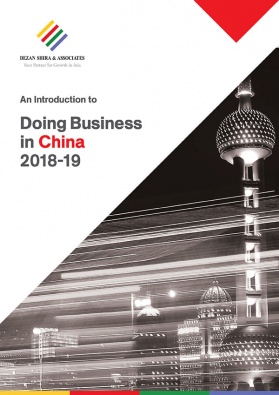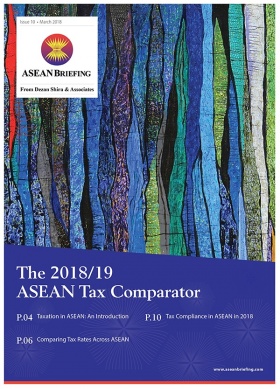A China Slowdown? More like an Asian Manufacturing Boom
Op/Ed by Chris Devonshire-Ellis
Various media, including Bloomberg, Financial Times, and New York Times, among several others, have been commenting on a “China Manufacturing Slowdown”. Gloomy talks about trade wars, and even some China blogs have been producing headlines such as “Would the Last Company Manufacturing in China Please Turn Off the Lights”. That blog suggests that, among their clients, “A huge chunk of American companies are looking to move their manufacturing from China.”
Strong words and predictions indeed. But let’s cut to the chase. They are largely nonsense. Why do I say this?
The reason is that I happen to be in Hong Kong for the Dezan Shira & Associates annual partners meetings, at which we analyze the year gone by and commence planning for 2019. We base our upcoming investment strategy and needs as a business on past performances, so what has happened during this year is of immense importance to our future direction and decision making for next year. With us about to complete our 26th year of operations in China, there is a lot of behavioral data we can examine. Plus, with 13 offices throughout the country (including Hong Kong), we can look at a lot of regional data too. So why do we disagree with the esteemed company of global newspapers quoted above and various China blogs?
Firstly, the recent broadsheet media coverage. In writing about China, and the apparent slowdown, they have all taken as their cue the Purchasing Managers Index (PMI) latest rankings, which put China at 50.2. A figure above 50 is expansion, a figure below contraction, and the 50.2 figure has dropped from 50.8 a quarter ago. Obviously if the PMI index shows that purchasing managers are buying less, this could signal a slowdown in demand.
However, there are two issues with relying only on this data. First, because it is only one source. Second, because it is a China national figure – it includes economic backwaters, such as Tibet, and does not reflect Chinese regional variations. Ergo, just because the Chinese PMI data indicates a slowdown, it doesn’t necessarily mean that China’s manufacturing centers are slowing down. The latter question is a regional one to be answered, not a national one.
In terms of China Law Blog‘s tongue-in-cheek comment about turning out the lights in China’s manufacturing industry, that too tells a story, but only partially so. It also tells us rather a lot about the nature of their consulting firm and their clients, however, that is a separate analytical issue.
The reason I say that it tells only a partial story is because Dezan Shira & Associates annual figures for 2018 January-October show a rather different picture. In fact, our revenues in China, which are largely driven by foreign investment from US and EU manufacturing and service industries, went up this year by 9 percent. That is more than China’s 6.5 percent GDP growth for the year. So why the disparity?
The reason is the regional variants. We are a countrywide firm in China with 12 mainland China offices. These are spread across south China (Guangzhou, Shenzhen, Dongguan, Zhongshan), east China (Shanghai, Hangzhou, Ningbo, Suzhou), and north China (Beijing, Tianjin, Dalian, Qingdao). We service foreign invested clients in all of these regions. That client base – made up of hundreds of businesses – means we can analyze what is happening between regions. What is essentially occurring is that south China is fairly flat in terms of growth – I will come to the reasons later.
Revenue growth in Shanghai and east China is up by about 15 percent, while Beijing and north China show around 8 percent growth. As these are mainland China’s principal manufacturing regions, it makes sense to look at those areas for an understanding of how purchasing managers think. That overall picture – with the possible exception of south China’s low growth rates – does not equate to China’s entire manufacturing industry. It also does not necessarily point to an overall ‘slowdown’.
However, there are obvious signs of shifting growth. Again, one needs feet on the ground to properly understand this. Part of the reason for the low south China figures is the emergence of Southeast Asia as a manufacturing hub. However, that primarily affects just one type of manufacturer, and not all. It is the export driven manufacturers who have been looking at cost comparisons – those who manufacture overseas but sell to target markets in the US, Europe, and so on. They will relocate operations elsewhere when their bean counters see that the supply chain is better off being situated somewhere with a lower cost base. However, this has been going on for years, and it will continue to be the case. There is nothing new in manufacturers relocating part, or even all of their manufacturing capacity, away from China. In fact, a large percentage of China’s textiles industry decamped to Bangladesh a few years ago – which is why that country today is now one of the world’s largest producers of fabrics.
It is also true that we are a well-established practice and have a sound business model, proven over 26 years, that we occasionally tweak from time to time to keep abreast of things. Some of that tweaking occurred nearly a decade ago when the decision was made to expand Dezan Shira & Associates out of China and elsewhere into Asia. That was because we saw, even then, the emergence of companies questioning the real cost of doing business in China.
I wrote an article about it at the time, “The Communist China Price”, which highlighted the exact areas where China was becoming uncompetitive. As a result of that, we established offices in Vietnam and India, considered a bold move (some thought crazy) at the time as China was apparently doing so well. Later, we moved into ASEAN and began operations in several of those countries as well.
Sure enough, export manufacturing began to move from China and into Vietnam and other ASEAN destinations, a trend that is nine years old. Hardly new. But what of today?
Our Vietnam operational revenue grew by 35 percent this year to date. Considering that comes from a base nearly ten years old, that’s a hefty increase. Following that was India (10 percent), again a country where we have been now for just over a decade. These are steady growth patterns produced by already well-established Dezan Shira & Associates offices in these countries. But what is even more exciting, albeit from a more recent, and therefore lower revenue platform base, is our 2018 growth in Thailand (100 percent), Philippines (150 percent), and Indonesia (400 percent). So yes, ASEAN has been taking FDI away from south China.
However, even that does not tell the whole story. South China has lost an export manufacturing base to ASEAN, but it is also losing manufacturing for the Chinese domestic market, mostly to Zhejiang Province. In fact, across the board, and despite what media often suggest, manufacturing FDI into the Chinese domestic market is on the increase. These are businesses, often rather larger companies, who continue to see China as a huge domestic market and are investing there. Zhejiang, benefiting from the financial facilities offered by Shanghai, is becoming a central base for Chinese and international manufacturers, both wishing to sell to the mainland Chinese market. That is why we see foreign manufacturers originally based in south China relocate into east China, where the access to finance, HR, supply chains, and distribution networks are better. It’s why our east China operations centered around Shanghai grew by 15 percent this year.
Another myth we can disregard is the statement made, again somewhat recklessly by China Law Blog, that US manufacturers are leaving China. That comment, although it doesn’t say as much, is directed mainly at south China, and is only an export manufacturing driven, economic issue as businesses search for ever cheaper labor. In 20 years’ time, those manufacturers will be eying the east coast of Africa. Others though are leaving south China for east China. As for US reshoring? It’s not happening. The US remains an expensive place to house a business. Additionally, we have first-hand news from US firms as to what is going on. How? Because Dezan Shira & Associates are members of an organization known as the Leading Edge Alliance, a network of the largest non-Big Four firms around the world. Their annual meeting has just been held in San Diego, attended by our China operations Managing Partner Alberto Vettoretti and our US-based colleague Dustin Daugherty. With several hundred US partners of law and tax firms there from across the United States, we asked if any were dealing with American companies re-shoring from China or Asia. The answer was clear: “No.” That echoes our own experiences of US clients we support in China. We haven’t had any discussion about relocating back to the US this year. And we service several hundred US clients in China. Myth busted? Yes.
Still in San Diego, on the related subject of the US-China Trade War, the overall view was that US President Donald Trump is dealing with China as a businessman, and unlike the EU, will stand up to China and insist on getting his way (the EU have instead been holding negotiations after negotiations with China over a Free Trade Agreement since 2013 with no progress). Trump is currently pre-occupied with the mid-term elections, but afterwards, will turn his head back to the China issue. While China’s President Xi Jinping will not want to be seen to be cowed by Trump, a deal will emerge. Timeframe? Q1 or Q2 of 2019.
So – away from the headline grabbing “China Slowdown” and “China Lights Out” stories – what are the real trends?
Again, we can refer to on-the-ground knowledge rather than histrionics. If we look at the recent Amcham China and Eurocham reports, there is no indication of “a huge chunk” of businesses leaving China. Some are partially removing production elsewhere but there is no en masse movement of manufacturing business going away. What has happened in the short term is that the US-China Trade War has pushed out low margin manufacturers who had previously been sitting on the fence and contemplating whether China Plus One made sense or not. Many could still sustain 10 percent of additional tariffs when selling to the US, but at the new 25 percent rate, they have been forced to act. However, these are SMEs, mostly with low capital base investments. Our estimate is this is no more than 10 percent of the total businesses affected. That is also what Dezan Shira & Associates sees on the ground. Chinese Ministry of Commerce spokesman Gao Feng for has also commented on this, saying that “Uncompetitive exporters are likely to feel the brunt” and “at present, most enterprises are still confident in meeting the challenges.” We also agree with what the regional newspaper, the South China Morning Post, also reports: “China’s September FDI figure rises as foreign investor shrug aside concerns of trade war”. FDI into China is increasing, not decreasing, while the only businesses suffering are under-captalized export manufacturers.
We can also state categorically that foreign manufacturing is not leaving Asia either. The majority of Dezan Shira & Associates manufacturing clients in south China are also not shutting down, but are adapting. They are either keeping production in south China or scaling it down while they ramp up production in neighboring countries in ASEAN or east China. Echoing the South China Morning Post report, we can also see that FDI into Asia is growing – often at significant rates – while the global FDI trend is slowing with lower investments into US and Europe. Still, globally, the US remains the largest recipient of FDI. In Asia, there is a lot of intra-Asian FDI moving within the region. Asia is still investing in Asia.
It is therefore in China, ASEAN, and India that FDI figures are the most interesting. While it has long been the case that some export driven manufacturers have relocated part or all of their operations outside of China, other manufacturers keen on accessing the domestic market (and neighboring Asian markets) are still heavily reliant on the local supply chain. They are very unlikely to leave China anytime soon, resulting in certain industries continuing to invest in the country. Our 9 percent year-on-year revenue increase from foreign investors investing in China is higher than China’s own GDP growth figures. So, no, manufacturing businesses are not pulling out of China.
Elsewhere in Asia, the figures from our firm are quite clear. Our Vietnamese revenues are up by 35 percent, India by 10 percent, and the emerging ASEAN nations of Indonesia, Thailand, and Philippines are all showing significant FDI growth. Again, the investment figures we are handling on behalf of foreign investors into these countries are higher than the related GDP growth for each of them.
There is no China manufacturing slowdown, companies in China aren’t necessarily leaving, and no, no-one will be turning off the lights. As for where our significant recruitment and investments for Dezan Shira & Associates go for 2019, ASEAN will have the lion’s share. Just as we predicted a decade ago.
On a concluding note, I think it is also important to point out that if your business is or wants to be a world class global manufacturer, you will have to have some sort of manufacturing or partial assembly base in Asia to develop and build up your brand and client base in the region. It is not possible to conquer the world from the US or Europe anymore. On where that “base” in Asia is, that is a big question mark these days, and it is firms with their feet on the ground – not those discussing these issues from desks in the US or EU – who are best placed to answer it.
About Us
Chris Devonshire-Ellis is the Chairman of Dezan Shira & Associates. The firm handles FDI and related professional services into China, India, and ASEAN, from some 28 regional offices. Please contact the practice at asia@dezshira.com or visit us at www.dezshira.com.
- Previous Article Investing in China’s Creative Services Industry
- Next Article Labor Contracts in ASEAN, Social Security in Vietnam, and Investing in India – China Outbound


























